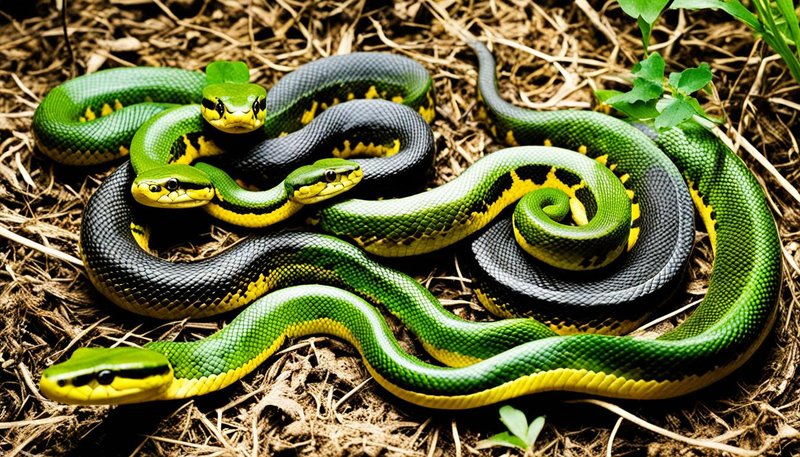
Let’s dive into this intriguing topic. Understanding how snakes breed can shed light on their behaviors, their habitats, and even their survival as a species. Whether you’re a pet snake owner or just curious about these scaled wonders, you’ll discover some engaging insights into the reproductive habits of snakes!
The Basics of Snake Reproduction
When discussing the breeding of snakes, the first thing to understand is that they are oviparous or viviparous. Most snakes, like the common garter snake, lay eggs (oviparous), while others, like the boa constrictor, give birth to live young (viviparous). This difference in reproductive methods brings us to the diverse world of snake species.
Regardless of whether a snake lays eggs or gives birth, the reproductive cycle typically involves mating rituals. During the breeding season, which often occurs in spring and early summer, many snakes will seek out a mate. In some species, males will travel long distances to find females, and this quest can lead to fierce competition. Imagine a bunch of guys trying their hardest to impress a single girl at a party; it’s a battle of charm and endurance!
The Mating Rituals
Snake courtship can be quite a spectacle. When a male snake locates a female, he often performs a series of movements to attract her. This may include rubbing against her, a behavior known as femoral marking, and even vocalizations. Yes, snakes can make sounds, although it’s subtle and not like the calls of birds or frogs.
Once the female shows interest, the real dancing begins! Males may engage in a behavior called “combat,” where two males will entwine their bodies and push against each other, vying for the attention of the female. It’s like an ancient wrestling match, but the winner gets the chance to mate. This playful yet intense interaction showcases the survival of the fittest principle.
The Actual Mating Process
After the courtship and combat rituals, if all goes well, the male and female will mate. Snakes have a fascinating reproductive organ called a hemipenes, which are dual organs that are everted, or turned inside out, during mating. This allows for sperm transfer to the female.
The actual mating can last several hours, and it’s not uncommon for the couple to stay entwined for an extended period. It’s like a dance that continues until they’re ready to part ways. After this union, the female will store the sperm until she’s ready to fertilize her eggs, a process that can take weeks or even months.
Egg-Laying and Gestation
For those snakes that lay eggs, finding the right spot for laying is crucial. They typically seek out warm, humid areas that are safe from predators. This can be a hidden burrow, under a rock, or even within a fallen log. Once they’ve found the perfect spot, the female will lay a clutch of eggs, which can range from as few as 5 to over 100, depending on the species.
The gestation period for snake eggs can vary widely. Generally, it can take anywhere from 30 to 90 days for the eggs to hatch. The temperature and humidity levels of the environment play major roles in determining how quickly the eggs will develop. Once hatched, the baby snakes typically must fend for themselves right away, showcasing the independent nature of these reptiles.
Live Birth: The Wonder of Viviparous Snakes
For viviparous snakes, the story is quite different. Instead of laying eggs, the female nurtures her young inside her body until they are ready to be born. This method provides several advantages, such as enhancing survival rates for the young. The embryos receive nutrients and oxygen through a structure similar to a placenta, which is fascinating and helps kick-start their survival journey.
After a gestation period that can last anywhere from 2 to 6 months, the female gives birth to live young. It’s a remarkable process that ensures the babies are more developed when they emerge compared to hatchlings from eggs. Just like any new mother, the female may exhibit protective behaviors until her young can manage on their own, which they typically do almost immediately after birth.
Challenges in Snake Breeding
Reproductive challenges exist for snakes, much like in many other species. Environmental factors like habitat destruction, climate change, and pollution can significantly impact their breeding success. For species with specific breeding requirements, losing the right conditions can mean fewer young survive.
Moreover, competition for mates can lead to lower reproductive rates among some species. When males fight for the attention of females, there’s the risk of injury. High levels of stress in the population, whether from human impact or natural predators, can also translate to reduced reproductive success.
The Importance of Understanding Snake Reproduction
Understanding the breeding and reproductive behavior of snakes is crucial for conservation efforts. Knowledge about their mating habits can help scientists develop strategies to protect endangered species. Plus, for pet owners, knowing more about their snake’s reproductive behavior can lead to better care and a deeper appreciation of these intriguing animals.
In summary, snake reproduction is a complex and dynamic process filled with unique courtship rituals and biological adaptations. From courtship to laying eggs or giving birth to live young, these reptiles exhibit behaviors that reflect their evolutionary adaptations to survive and thrive in their environments.
So, the next time you see a snake, remember that there’s a lot more going on than meets the eye, especially when it comes to their breeding and reproductive behavior!

